
Leopard
The elusive leopard, Panthera pardus, captivates with its rosette-spotted coat and stealthy prowess. A master of adaptation, it navigates diverse terrains, balancing ecosystems by controlling prey populations. Solitary and nocturnal, this agile predator often rests in treetops, exemplifying nature's perfect blend of beauty and power.
10-15 years
Lifespan
30.0 - 90.0 kg
Weight
Length: 1.0 - 1.9 m
Size
Yellow, Black, Dark, Brown, Golden
Color
2-2.5 years
Age of Sexual Maturity
3 months
Age of Weaning
36 mph
Top Speed
Vulnerable
Conservation Status
Decreasing
Population Trend
Characteristics
Panthera pardus, commonly known as leopards, are large felines found in sub-Saharan Africa, parts of Asia, and the Middle East. They are solitary, nocturnal hunters with distinctive rosette-patterned coats, powerful builds, and the ability to climb trees. Leopards are adaptable and thrive in diverse habitats, from rainforests to savannas.
Distribution Range of the Leopard
Panthera pardus, commonly known as the leopard, is native to a wide range of regions across sub-Saharan Africa, parts of North Africa, and Asia. This includes countries such as South Africa, Kenya, Tanzania, India, Sri Lanka, China, and the Russian Far East. The species' range extends from the Arabian Peninsula, through the Middle East, and into the Indian subcontinent.
Leopard's Habitat
Environmental Conditions
Leopards are highly adaptable animals and can thrive in a variety of environmental conditions. They inhabit savannas, rainforests, woodlands, grasslands, mountains, and even arid desert regions. Their habitats can range from sea level to altitudes of over 5,000 meters in the Himalayas. Leopards prefer habitats with good cover for hunting, such as dense bush or rocky outcrops, and they require access to water sources.
Ecological Niche
Leopards are solitary and territorial carnivores. They are opportunistic hunters with a diet that includes a wide range of prey, from small rodents to large ungulates. Leopards have adapted to survive in areas with varying prey availability and human development pressures. They are known for their ability to climb trees, which they use as vantage points for hunting and as a refuge from predators.
Copyright @ Nature Style Limited. All Rights Reserved.
 English
English